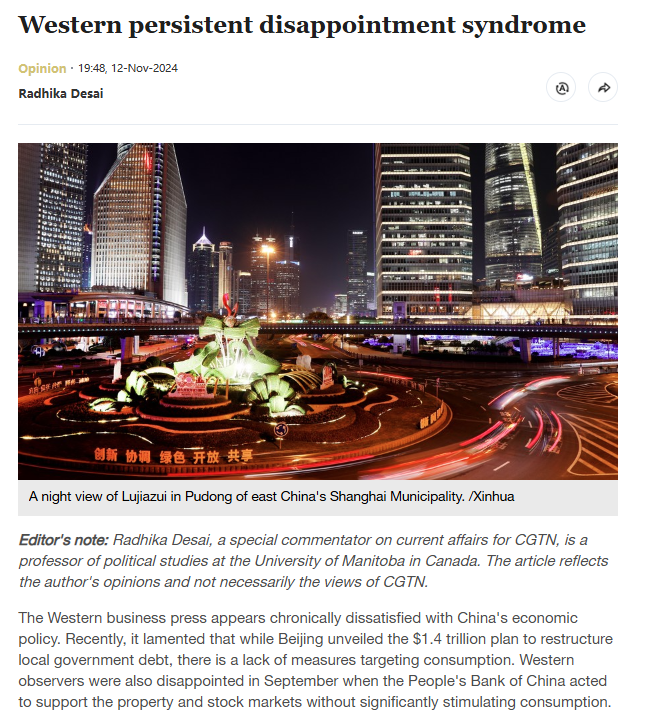LATEST INSIGHTS
Your Present Location: LATEST INSIGHTSRadhika Desai: Western persistent disappointment syndrome
Source: CGTN Published: 2024-11-12

By Radhika Desai
The Western business press appears chronically dissatisfied with China's economic policy. Recently, it lamented that while Beijing unveiled the $1.4 trillion plan to restructure local government debt, there is a lack of measures targeting consumption. Western observers were also disappointed in September when the People's Bank of China acted to support the property and stock markets without significantly stimulating consumption.
Such disappointment is likely to persist. It arises not from anything Chinese authorities are doing or not doing but from fundamental Western misunderstandings about what truly drives Chinese growth and how Chinese authorities manage it.
Nowhere is this misunderstanding more apparent than in Western reactions to the third plenary session of the 20th Central Committee of the Communist Party of China (CPC) in July. This plenum has long marked key turning points in China's storied growth path.
The resolution adopted at the plenary session announced the goal of pursing "revolutionary breakthroughs in technology, innovative allocation of production factors, in-depth industrial transformation and upgrading, and the optimal combination of laborers, means of labor, and subjects of labor, as well as their renewal and upgrading," which was expected to give rise to "new industries, new business models, and new growth drivers and promote the development of productive forces characterized by high technology, high performance, and high quality."
Deaf to this impressive ambition, the Western press reverted to harping on Chinese consumption. The Financial Times complained that the communiqué contained a "disappointing omission": a failure to "reorientate its growth model away from an over-reliance on investment and exports towards household consumption," which would reduce China's huge trade surpluses and invigorate global demand.
There we have it: the West wants China to solve its problems of lack of competitiveness and trade deficits by consuming more of its own goods and buying more of the West's goods.
However, the West is free to "protect" its markets if it so wishes. After all, it has already thrown the WTO off a cliff. Its real problem is that it dares not do this. It is addicted to China's low-cost and high-quality imports. Nor can the West improve its own competitiveness easily, as was clear from the underwhelming record of the Biden administration's various industrial policy initiatives. No wonder the West wishes the Chinese government would address its problems.
However quite understandably, expanding consumption at the expense of investment is unrealistic. Exports are another matter, and China, in face of rising protectionism and anti-globalization, already announced its dual circulation development pattern of rebalancing exports against domestic consumption and investment in 2020.
In this context, China's exports are still rising: its trade surplus in 2024 is reaching near record levels and, if exports continue at the same pace in the closing months of the year, is set to reach almost $1 trillion, according to Bloomberg.
However, reducing investment is quite another matter. The simple fact is that China's consumption levels have been growing rapidly, doing so precisely as a result of the fast growth enabled by the high levels of investment. Continued and sustainable increases in Chinese consumption rely on high levels of growth that, in turn, rely on high levels of investment.
There is no shortage of measures to expand consumption in the resolution adopted at the third plenary session, including expanding welfare and social security, improving health and education services, as well as addressing quality of life issues such as the environment and expanding cultural opportunities.
China will not only continue to emphasize investment, but it also intends to do so qualitatively new ways by putting China's economy on a path to ever-higher technological sophistication through "promoting the development of strategic industries such as next-generation information technology, artificial intelligence, aviation and aerospace, new energy, new materials, high-end equipment, biomedicine, and quantum technology."
To this end, the Chinese government will reorient all systems – regulation, credit, education, industrial policy, government spending and capital markets – as detailed by the resolution adopted at the third plenary session.
This approach has already recorded its successes. The Australian Strategic Policy Institute (ASPI) points out, for instance, that China leads in 37 out of 44 technologies that ASPI is tracking, covering a range of crucial technology fields spanning defense, space, robotics, energy, the environment, biotechnology, artificial intelligence (AI), advanced materials and key quantum technology areas.
This shows that China can and will continue to expand its consumption, powered by high investment levels, now in increasingly sophisticated technological fields.
Key Words: Radhika Desai, RDCY, China, the West























































































 京公网安备 11010802037854号
京公网安备 11010802037854号





